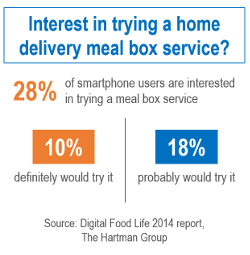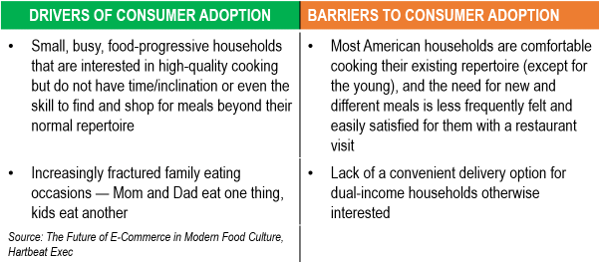Fear and loathing in the kitchen: home delivery meal kits to the rescue?
 We’re a food-obsessed culture. Foods and beverages have moved well beyond providing mere sustenance; food is now a cultural product to discover, share, make and trade. We’re so fascinated with food, yet we fear facing that daily question, “what’s for dinner?”
We’re a food-obsessed culture. Foods and beverages have moved well beyond providing mere sustenance; food is now a cultural product to discover, share, make and trade. We’re so fascinated with food, yet we fear facing that daily question, “what’s for dinner?”
One would think finding an answer would be easy. After all, cooking talk is everywhere — from schools and universities to internet, television and discussions around the water cooler at work.
Yet for all of this discussion, the very act of planning, prepping and cooking a meal at home remains a daunting proposition, in particular for a younger generation of consumers (due to lack of time and experience) and to anyone trying to cook an emerging cuisine not found in one's usual repertoire. Emerging (typically ethnic) cuisines are where the tastes and menus of urban restaurants risk humiliating us at the stovetop on any given evening.
But wait, a new breed of businesses has sprung up in the form of home delivery meal solutions that propose to help consumers overcome their anxiety surrounding planning and cooking meals. These companies (e.g., Plated and Blue Apron) are more closely aligned with contemporary food occasions and cooking habits, and consumers’ diverse tastes and preferences. They provide pre-measured, typically trendy ingredients and accompanying cutting-edge recipes that take most of the uncertainty and some of the prep work out of cooking a restaurant-quality fresh meal at home.
The question remains how far into the market can this idea really go and to what kinds of consumers do home delivery meal kit solutions “really” appeal?
If you guess "younger" consumers, you’d be right.
Our "Foodways of the Younger Generations – Millennials & Gen Z" report finds that the often hard-to-find, food-forward ingredients, meals and recipes offered by such services are likely to find high appeal with more digitally inclined generations. Specifically, this is because Millennials and Gen Z (both being true "digital native cohorts") are the most ethnically diverse demographics, which affords them the opportunity to incorporate eating habits from across many different cultures. This diversity is influencing food culture trends around the exploration of authentic, global food experiences.
While often pointed to as the eating-out generation, Millennials actually like to cook. The Foodways of the Younger Generations report finds that 63 percent of Millennials say they enjoy cooking, followed by 57 percent of Gen Z. And yet 19 percent of Millennials say they rarely have the time or energy to cook, and a similar number (18 percent) say they only know how to cook a few things (followed by 34 percent of Gen Z).
This is why the recipes and globally inspired ingredients included with most meal kit delivery services are well-matched to a group of consumers eager to cook ethnic but who may not have the time, skills or necessary ingredients to accomplish the goal.
 Millennials are culinary adventurers as well: Chinese, Thai, Indian, Mexican, Greek, Mediterranean — this cohort is willing to explore global cuisines and try different types of food products, including spices, oils and flavorings.
Millennials are culinary adventurers as well: Chinese, Thai, Indian, Mexican, Greek, Mediterranean — this cohort is willing to explore global cuisines and try different types of food products, including spices, oils and flavorings.
Of course, desires to explore global and emerging ingredients and cuisines are not exclusive to younger consumers — other likely candidates for adoption of home delivery meal kit services include small, busy, food-progressive households that are interested in high-quality cooking but do not have time, inclination or even the skill to find and shop for meals beyond their normal repertoire.
Ingredient and recipes-in-a-box delivery services are also especially appealing to those who lack easy access to high-quality specialty ingredients due to limited grocery infrastructure (in rural areas, for example). Also, food culture itself is composed of increasingly fractured family eating occasions — Mom and Dad eat one thing, kids eat another, and "planning" and acquiring ingredients for globally inspired cuisines can have limitations.

Whether or not home delivery meal kit services will grow to significance is anyone’s guess, given how young such services are. In our view, key channels for digital food procurement vary significantly according to their overall potential scale. This variance does not necessarily parallel how disruptive a specific channel is or how quickly it might become adopted. Sometimes the most disruptive, rapidly scaling businesses are niche markets in the near (and long) term.
Digital technology facilitates shopping and cooking disruption in complex ways. It is clear that brick-and-mortar grocery will lose measureable market share, in part to restaurants but also to direct-to-consumer channels that go from farm to kitchen or from kitchen to kitchen. Improvements in logistics and IT are already in existence to support the latter.
The home delivery meal box service championed by Plated, Blue Apron and others has certainly caught the eye of progressive food retailers, CPG companies and lifestyle brands. As reported earlier this year by Food Business News, Tyson and Kroger have openly expressed interest in expanding into the meal kit delivery business, and Sequential Brands Group (owner of Martha Stewart Living Omnimedia) is partnering with “Marley Spoon, a subscription meal delivery service, to convert Ms. Stewart’s 18,000 recipes into meal kits.”
As we have transitioned from traditional culture to participatory food culture in the digital age, we find that traditional relationships between industry and consumer are falling victim to significant disruption.
This disruption is digital. And it is affecting all facets of consumer life — especially in the digital food marketplace.
Consumers are increasingly bypassing traditional retailers and purchasing foods directly from alternative sources online. New services and products are emerging to align with the cultural shifts in how consumers eat-shop-live. Many will disappear, but others may become the “Apple” or “Amazon” of food as discoverable, sharable, makeable and tradable content.
